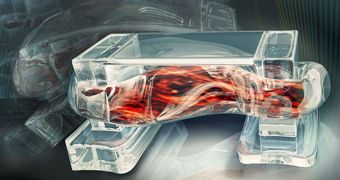A paper published in the online early edition of the journal Proceedings of the National Academy of Sciences details the development of a new generation of teeny tiny robots that move about with the help of actual muscle cells.
These miniature robots are the brainchild of scientists with the University of Illinois at Urbana-Champaign in the United States and measure about 6 millimeters (about 0.2 inches) in length.
In a press release on the matter at hand, the researchers explain that their robots are made of flexible 3D-printed hydrogels and living skeletal muscle cells. Hence, they are referred to as bio-bots.
In terms of design, the miniature robots are surprisingly uncomplicated. In fact, their anatomy is roughly the same as that of actual joints found in nature, the University of Illinois specialists say.
Thus, the bio-bots comprise a backbone of 3D-printed hydrogel, and two posts that help make sure the muscle strips are well anchored to the backbone and also help them move about by acting like feet.
As detailed in the journal Proceedings of the National Academy of Sciences, these bio-bots are able to navigate their surroundings by flexing the muscles that they are fitted with. Electrical pulses serve to trigger contractions.
According to the scientists behind this research project, higher-frequency electrical pulses cause the bio-bots muscles to contract at a fairly rapid pace, as shown in the video below. The result is that the miniature robots move faster.
When the bio-bots are exposed to low-frequency electrical pulses, on the other hand, they look less like they were running and more like they were enjoying a peaceful walk in the park, the University of Illinois specialists say.
Interestingly enough, it was back in 2012 that these researchers began work on developing these unique bio-bots. At first, they used heart muscle cells to power the miniature robots. However, they turned to skeletal muscle cells when they found that these were more easily controlled.
“Skeletal muscles cells are very attractive because you can pace them using external signals. You would use skeletal muscle when designing a device that you wanted to start functioning when it senses a chemical or when it received a certain signal,” explains study leader Rashid Bashir.
The scientists wish to continue their work and are now looking into the possibility to gain better control of their bio-bots by integrating neurons in their design. They say that, in time, this technology could translate into the development of biological machines that have no need for conventional motors.
“It's exciting to think that this system could eventually evolve into a generation of biological machines that could aid in drug delivery, surgical robotics, ‘smart’ implants, or mobile environmental analyzers, among countless other applications,” says specialist Caroline Cvetkovic.

 14 DAY TRIAL //
14 DAY TRIAL // 